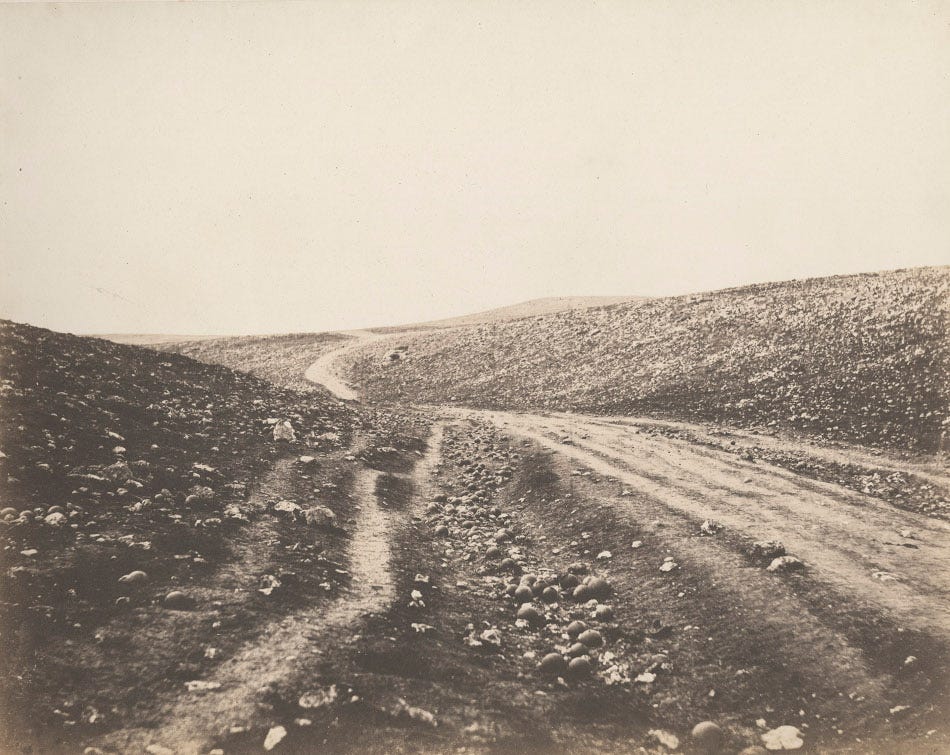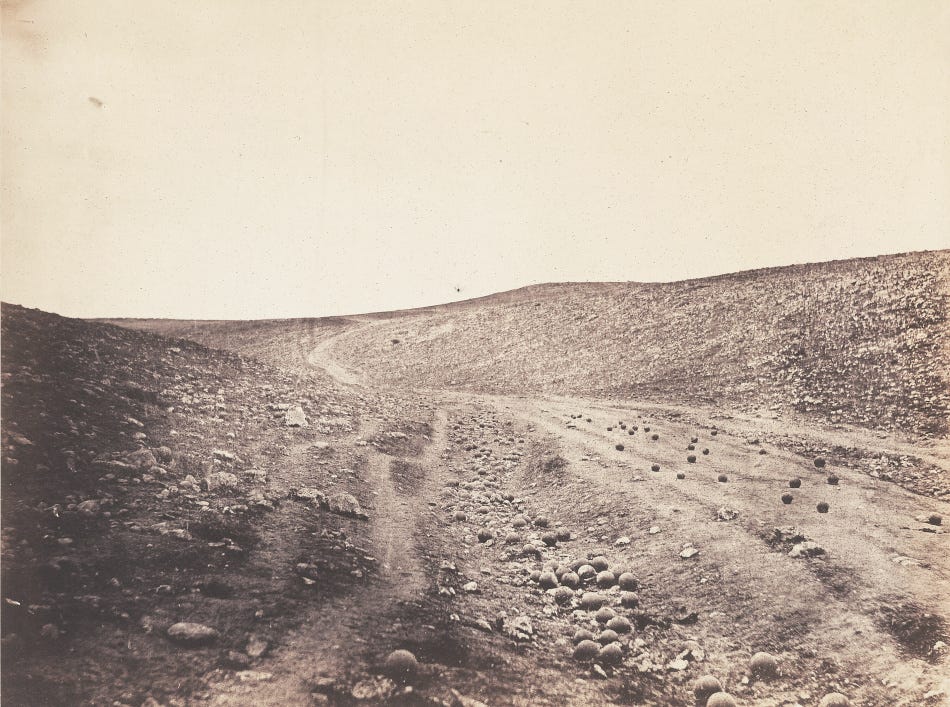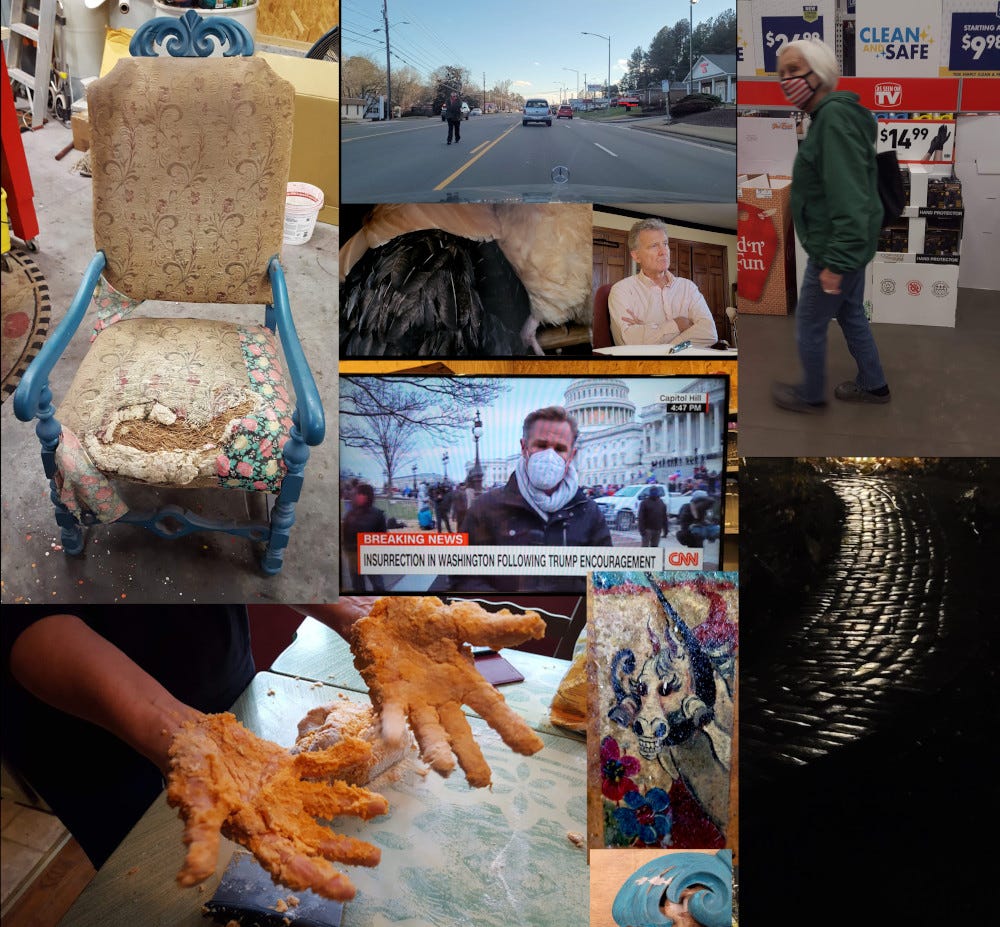Flimsy film, ethereal pixels. Pictures and us.
An image captured, rectangularly framed. The 35mm frame-of-mind. Cannonballs, OFF and ON. "Seeing machines."
Forward this post to a friend. Thanks.
My colleague Augustus Wendell visited my class last fall, the first of several guests who made appearances and the only one to address directly the relationship of art and technology. He opened up his presentation to the class with a couple of photographs taken in the mid-nineteenth century by Roger Fenton during the Crimean War — two pictures from the same tripod position of a barren landscape and a winding road. The difference? Cannonballs. One shows cannonballs strewn on the road, the other shows them in the ditch. When he went down the rabbit hole of scholarship on the photographs, film-maker Errol Morris labelled the pictures “OFF” and “ON” — “the-photograph-with-cannonballs-off-the-road and the-photograph-with-cannonballs-on-the-road.”


Aesthetic effects of the images of course differ rather dramatically, and that difference has drawn scholars’ attention. Morris summarized the disagreements quite well in his New York Times “Opinionator” article from September 25, 2007: A) the cannonballs were placed on the road at Fenton’s request, B) they were removed at Fenton’s request, or C) neither, because they were in the process of being “harvested” by soldiers who were going to shoot them back at the enemy. (I tend to “C,” if it matters. Or “A,” maybe.) Wendy Ju has a nice web page where you can click to compare the two versions, and Morris’s analysis looks beyond the cannonballs to the position of individual stones in the ditch.
Did Fenton’s manipulations of the landscape add up to fraud? Susan Sontag thought so, as did Morris eventually, but I think calling Fenton’s choices fraudulent is going too far, especially since war photography in the nineteenth century was predominantly staged in any case. Fenton no doubt wanted his photograph to capture a dramatic war landscape — and he made an artistic decision that by today’s standards would count as tampering.
In the mid-nineteenth century, photography was young and limited, but storytelling is as old as human speech. Storytelling adapted to the plodding recordings of photographic contraptions, and in Fenton’s day norms of documentary photography were still being formed.
Going digital
It’s worth remembering that the staged quality of early war photography was in part a consequence of the technology of the time, which required long exposures. Cannonballs on or off roads do not move, but people do. And so, camps and generals and lieutenants unnaturally froze action for the sake of creating a clear picture. Natural flits of eyes and shifts of posture rendered blurs because of photographic technical limitations.
Such nudges and contours that technologies impress upon storytelling seem to recede when tools become sufficient and fall into a sort of invisibility, but it’s mistaken to think that photographic technologies simply receive and record what’s presented, “fast” highly sensitive film and near-instantaneous shutter speeds notwithstanding. They still involve processes that shape our perception, our consciousness. Accurate within the framework of the technology, captured images leave out and bring in elements of life, just as narratives do.
I ran into the nudges of the medium in January 2020 when I began “an experiment in photography and daily journal writing” that was inspired by poet Bernadette Mayer in the early 1970s. Mayer took a 36-exposure roll of film every day in July 1971 and wrote in a journal. Her focus was “memory,” and the effort culminated in a gallery show in February 1972 called Memory. It included 1,116 photographs and played a nearly seven-hour-long recording of the journal. In 2020, Siglio Press issued Memory in print form.
My question: Could Mayer’s Memory project be adapted in January 2021, my first month of “retirement”? Could I use its model to gather information about that transitional month in an unsettling pandemic year?
Even before I snapped the first shot on January 1, 2021, changes in photography since 1971 made a simple adaptation (or crass adoption) of Mayer’s model impossible. The 35mm film camera snapshot was not, say, an Instagram or the like, and I considered the differences carefully in late December as I planned for the month. When the month was up, I had failed in my attempt to match Mayer’s number of photos — I’d chosen “between six and seven hundred shots” from piles of images — but I had also written around 20,000 words. They were not nearly as poetic and stream-of-consciousness as Mayer’s. I’m not a poet, after all, and I was not a 26-year-old, as she was in 1971. But they served another purpose, and I tended to view the project, which I called Retooling, as a gathering of “data” rather than as an artistic endeavor.
That purpose reflects the fact that technologies of image capture utterly transformed in the decades between Mayer’s Memory of July 1971 and my Retooling of January 2021. Looking back at my experiment in January 2021, I clearly see that the technologies of image capture made Mayer’s project an un-useable model. Memory could be an inspiration, an artifact to consider — and to move beyond.
Mayer’s 36-exposure per day restriction must have influenced how she chose her shots. Film and processing were expensive and tedious. But fifty years after her project, I had no practical limit, and as a result of technological progress the notion of “composition” for me had morphed into something completely different from the resource-restricted, hands-on, and fiddly experience of yesterday’s film photography.
On New Year’s Day 2021, my cameras surrendered more images than Mayer’s whole month-long project in 1971. “Today’s harvest of images pushed toward 1600,” I recorded in my first journal entry — the gross yield from time-lapse automation on two cameras, my old work smartphone and a nearly worn-out tablet that I’d consigned for use in the garage. So, I had images. Many, many tedious and robotic images. My role shuffled off to winnow the tedium and the sameness, where I could hope for a break of something new and interesting. “Composition be damned,” I had thought, “let the cameras overflow, pick the ‘best.’ And worry about what is, actually, the ‘best.’”
But on that first day of the project, I wrote
One thing I noticed during the day was that the automation of photography made the images feel like surveillance, and I think the circumstances of surveillance bear some thinking in coming days. The intentionality of “taking a picture” changes dramatically (I think) when your role in taking the picture is reduced to aiming a camera and setting a little computerized process into motion.
Who’s taking the picture?
Composition happens before and at-the-moment, not at the lightbox days later. The month-long project taught me that. And in fact many of the pictures that I now see as part of a story, as opposed to a stream of surveillance images, came from my choice and finger-click on the little glowing red button on my phone camera.

The developments that nudged me from the viewfinder to overwhelmed curator or “chooser” have caused some turmoil among professional photographers, who have seen their livelihoods wither and the whole notion of photography placed into a shadow of doubt.
Trevor Paglen considered the question “Is Photography Over?” in a four-post series for Fotomuseum Winterthur and wrestled with shifts that image capture technologies have imposed on the notion of “photography.” Paglen notes that
the rise of digital photography and image-processing has fundamentally altered the craft. Digital cameras are cheap and ubiquitous; image-processing software … has made it extraordinarily easy to produce an image-quality that was previously only possible with years of specialized training in equipment, shooting technique, and printing methods.
Besides that, images are everywhere, a flood even in 2014 when he wrote his posts with 250 billion photographs on Facebook and a world in which the “average person sees over 5,000 advertisements a day.” So, image capture is everywhere, and photography’s reliance on talent seems tenuous. Image capture is just there (and everywhere) in what Paglen calls “seeing machines.” Mishka Henner responded to Paglen’s first post, and he referred to “Documentary Photography” as “a world with no auteurs, where one style and the single viewpoint are irrelevant, and where poetry and lyricism are mere follies.”
Paglen’s idea of seeing machines deflects the question of who “sees,” who frames and captures an image. And in a world of seeing machines, really who “decides” a picture, that is, who can actually be Henner’s “auteur”? At best, among seeing machines, the maker emerges (if at all) from the mass, the hairballs of networked connections, the swirlings of repeated linkages.
But a photograph requires a human eye and an engaged mind, if it has a chance to be be considered expressive or maybe even as art. A mind sees a road with or without cannonballs and pulls a story together, or vice versa. Photography isn’t over, at least as long as humans choose to look from a viewfinder, guide steps of “image-processing,” and engage with others’ pictures (even the pictures offered by seeing machines, as Henner does in much of his work). Automated surveillance and seeing machines have diverged from photography, which is a human project, yielding a truth about human experience.
Richard Avedon, who I don’t think ever commented on Roger Fenton’s pictures, said, “There is no such thing as inaccuracy in a photograph. All photographs are accurate. None of them is the truth.” Makes me wonder what he would think about the OFF and the ON prints. Neither The Truth, both accurate. But narrative — where story might emerge into a meaning, a source of truth? There, photography lives on.
Tags: Roger Fenton, Trevor Paglen, Mishka Henner, Errol Morris, Bernadette Mayer, Richard Avedon, photography, war photography, surveillance, 35mm film, digital photography
Links, cited and not, some just interesting
Internet and memory: Ingram, David. “The Internet Is Tricking Our Brains.” NBC News, December 9, 2021. https://www.nbcnews.com/tech/internet/internet-tricking-brains-rcna7193.
Film and digit: Kunzru, Hari. “Rich Image, Poor Image.” Harper’s Magazine, October 11, 2021. https://harpers.org/archive/2021/11/rich-image-poor-image-deepfakes/.
Geographies: Paglen, Trevor. “Is Photography Over?” Fotomuseum Winterthur, March 13, 13, 24; April 11, 2014. https://www.fotomuseum.ch/en/series/is-photography-over/.
Leaving Earth, shaping our consciousness [Video presentation]: The Photographers’ Gallery. “Screen Walk with Mishka Henner.” Accessed December 28, 2021. https://thephotographersgallery.org.uk/whats-on/watch-screen-walk-mishka-henner.
On Fenton: Grant, Simon. “A Terrible Beauty: Roger Fenton.” Tate, September 1, 2005. https://www.tate.org.uk/tate-etc/issue-5-autumn-2005/terrible-beauty.
More on Fenton: Orbach Natanson, Barbara. “Witness to History: Roger Fenton’s Photographs of the Crimean War.” Picture This: Library of Congress Prints & Photos, March 23, 2017. https://blogs.loc.gov/picturethis/2017/03/witness-to-history-roger-fentons-photographs-of-the-crimean-war/
Memory in print: Mayer, Bernadette. Memory. Catskill, NY: Siglio Press, 2020.
My chair project, January 2021: “A Chair Moves From Garage to Bedroom.” The Shadow. February 9, 2021. https://medium.com/the-shadow/a-chair-moves-from-garage-to-bedroom-85d4891a5ce9
And, for something completely different: The Museum of Jurassic Technology, https://mjt.org/, Culver City, California (H/T @rachsyme)



